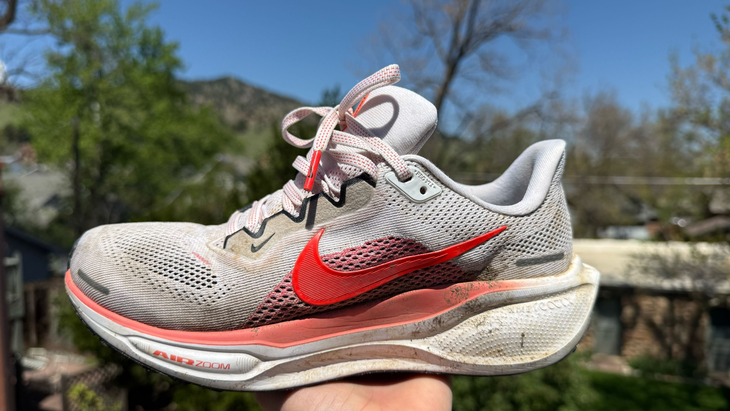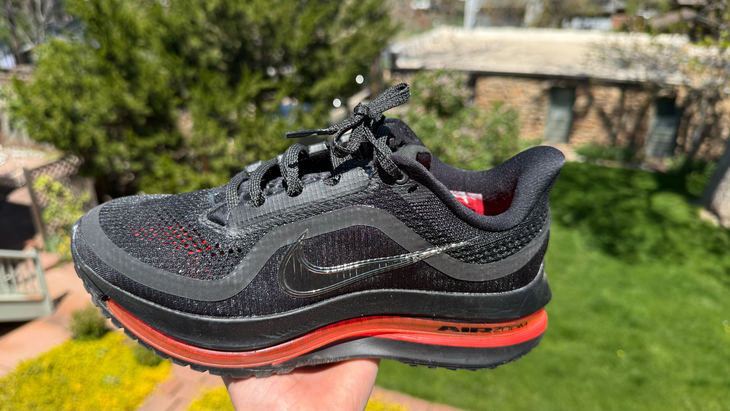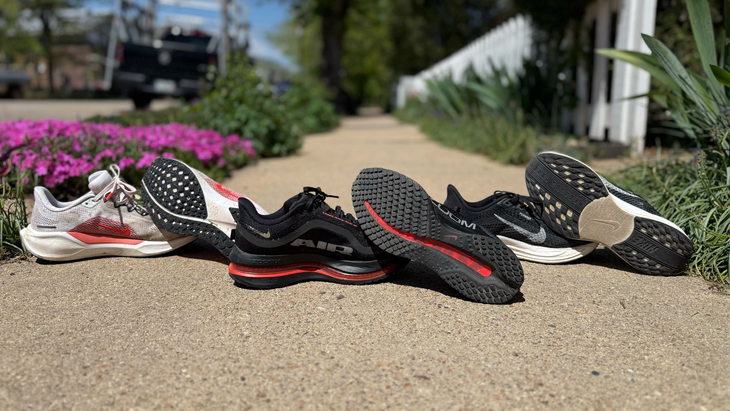New perk: Easily find new routes and hidden gems, upcoming running events, and more near you. Your weekly Local Running Newsletter has everything you need to lace up! Subscribe today.
Nike Pegasus fans, we have a problem. (Or as my running coach would tell me, an opportunity.)
With the release of the Nike Pegasus Premium on May 10, Peg people can now choose from the Nike Pegasus, Nike Pegasus Plus, and Nike Pegasus Premium.
What are we doing here, Nike, trying to pick which button to press on the gas station pump?
I’ve been running in the Nike Pegasus since 2009. That was the Nike Pegasus 26, I believe, and with its blocky outsole and highly paneled and structured upper, I probably could have run straight from cross country practice to the basketball court.
(Never mind that the Nike Pegasus 26, like the 25 models before it dating back to 1983, quietly embodied one of the lightest and sleekest daily trainers available at the time.)
Nike has continued to rework this daily trainer nearly every year for 42 years, harnessing the newest foams, fabrics, and technologies to varying degrees of success. The Nike Pegasus 41, the newest model on the market, uses two air pockets (“Air Zoom units”) and Nike’s proprietary ReactX in the midsole to provide a responsive-enough ride with a Goldilocks level of cush, in my experience. And I found the engineered mesh upper to be slimmer, lighter, and more breathable than ever.
The Peg is the shoe I turn to when I don’t want to think about what’s on my feet. Just like back in college, I find myself running in it pretty much every day.
So why did Nike have to go and make things so complicated with the Nike Pegasus Plus, released last summer, and Nike Pegasus Premium? Like gas at the gas station, the “regular” Pegasus is the least expensive, the Plus comes in at an upper-mid-tier price point, and the Premium tops out the trio at $210. Does more expensive equal more better?
I was curious, so I decided to conduct my own three-way test.
The results were not what I expected.
Nike Pegasus Comparison
| Specs | Nike Pegasus | Nike Pegasus Plus | Nike Pegasus Premium |
|---|---|---|---|
| Price | $140 | $180 | $210 |
| Weight (women’s size 8) | 8.8 ounces | 7.2 ounces | 9.7 ounces |
| Stack Heights | 37–27 mm | 35–25 mm | 45–35 mm |
| Heel-to-Toe Drop | 10 mm | 10 mm | 10 mm |
| Pros | Reliable, versatile, durable | Light, responsive | Flashy aesthetic, springy |
| Cons | A tad heavy, not enough foam in heel for forefoot strikers | Narrow, limited cushioning, non-gusseted tongue | Unstable, heavy |
| Best For | Daily training | Faster, shorter training | Lifestyle |
Nike Pegasus 41 Initial Thoughts

What can I say, slipping on the Nike Pegasus 41 feels like coming home. This reliable daily trainer is much improved over the middling Pegasus 40 thanks to a few key upgrades.
The ReactX foam feels a little peppier. The silhouette has gotten a facelift, with a rounded Air Zoom bubble under the forefoot and an additional millimeter of stack height. The engineered mesh upper is lighter and more breathable, while the tongue and heel collar have just the right amount of plush for easy runs. The cushioning remains just in that sweet spot, in my opinion—not so plush that I just want to jog (like in the Nike Vomero) and not so firm that my joints ache.
Easy days, slightly uptempo long runs, doubles, dirt, pavement, and even non-technical trails—the Nike Pegasus 41 handles it all with grace. If I had to choose one running shoe for the rest of my life right now, this would be a strong contender.
It’s not the most responsive trainer, and the cushioning could use a little readjusting (too much in the heel, not quite enough under the forefoot). But it’s a welcome reprieve (and needed wake-up for my feet) from workouts in maximally-cushioned carbon-plated shoes. And most importantly, it’s just plain old reliable.
Nike Pegasus Plus Initial Thoughts

I’d like to file a complaint with the Nike naming department. Yes, we get what you were going for here, Nike—add “plus” to the end of anything and it sounds marginally better. But the Nike Pegasus Plus is really the reincarnation of the Nike Pegasus Turbo, and we all know exactly what “turbo” means. Even after testing these three shoe models for several months, I continue to get the Plus and the Premium mixed up.
And yet, the ambiguity of this new naming convention is exactly why this three-way review exists in the first place.
Well played, Nike, well played.
On first wear, I found the Peg Plus, ironically, too minimal. It runs narrow through the midfoot, and the ZoomX midsole, while relatively reactive, felt thin underfoot, especially in the midfoot and forefoot. It’s light, but not quite as cushy as I was expecting. The flyknit upper (maybe the best part of the shoe), suede tongue, and minimal heel cup reinforce this stripped-down feeling, to the point this shoe wreaks a bit of nostalgia for the minimalistic shoes of decades gone by. And maybe that’s why this shoe grew on me a little over the miles.
With the advent of super shoes, which I wear for most track workouts, fartleks, tempos, and the workout portion of some long runs, I don’t have much room for a light, more minimalist shoe in my rotation these days. I want the extra cush and comfort of something like the Peg on easy days, warm-ups, and cool-downs. But I’ve enjoyed the Peg Plus for those easy days, usually with strides, when I want my feet to feel just a little lighter.
Nike Pegasus Premium Initial Thoughts

Nike is billing the brand-new Nike Pegasus Premium as a “super trainer.” I’m not sold. Sure, it’s an engineering marvel: a newfangled, full-length Nike Air “plate” runs the length of the shoe, sandwiched between two layers of foam. (ZoomX in the midsole and ReactX in the heel.) The result, theoretically, is a smooth heel-to-toe transition and a springy ride that Nike says results in more energy return than any Pegasus model to date.
Indeed, I found the Pegasus Premium to be luxuriously cushy in the heel and springy underfoot. But any additional energy return seems to be cancelled out by the chunky 45–35 mm stack and hefty 9.7 ounces for a women’s size 8. It feels clunky, and far more akin to a basketball shoe than a trainer.
I’m a forefoot/midfoot striker, but I found myself wanting to heel strike to take advantage of the chonky heel and the spring-like effect of the air pod. A highly-padded tongue and heel collar, as well as thick mesh upper with reinforced support zones in the lateral and medial forefoot, adds to the bulk and heft. It’s just too much shoe for running, in my experience.
The basketball shoe feeling is accentuated by the aesthetic, which I actually love. The air pod is visible throughout the length of the shoe and along the middle of the outsole, and a reflective strip and metallic accents add literal flash.
It’s a head-turning shoe. I just don’t think it fits into the “super” trainer category, or even the trainer category. I’ve found myself turning to the Peg Premium for walk-commuting to the office and lift-at-the-gym-straight-to-dinner scenarios—but not for running.
Women’s available 5/10 at Nike
Putting the Pegs All Together
There’s an art to naming running shoes that, frankly, most companies have yet to master. If I can’t remember the name of the shoe I’m wearing 15 miles into a long run, something—acronyms, a letter (or several), made-up words—has got to give.
One shoe company that generally does get it right is Nike.
Evocative of the winged white stallion from Greek mythology, the Pegasus is a name this ‘90s kid can get behind. (Do I immediately think of the whimsical figurines from My Little Pony? Absolutely. Is that a bad thing? Absolutely not.) But after testing all three Peg models, I think Nike has made things a little overly and unnecessarily complicated this time.
Returning to our gas station analogy: By naming convention, the Peg should be the most basic, “lesser” model, with the Premium being the highest quality (and, presumably, fastest) and the Plus sitting somewhere in between.

In my opinion, the good old regular Peg is the premier shoe. What the Plus lacks (cush), the Peg delivers. What the Premium delivers (chonk), the Peg (mercifully) lacks. So for the least amount of your hard-earned money, you’re getting, in my opinion, the best all-around shoe.
But of course that’s just me. Some cars only run on Premium, while others perform best on Regular. Running shoes work the same way: If you never run in plated shoes, the Peg Plus may be a welcome, more nimble addition to your repertoire for days you want to feel weightless underfoot and in touch with the ground. And if you, say, warm up with a short run at the gym before hitting the weight rack, the Peg Premium Plus may deliver the flashy, squishy ride you’re seeking. And it’s guaranteed to turn heads.
